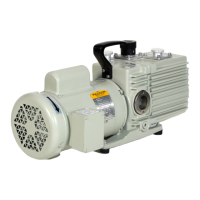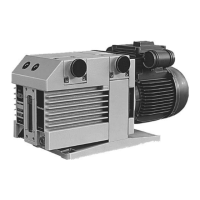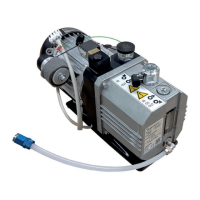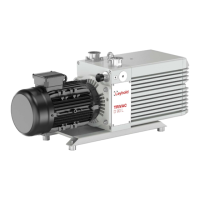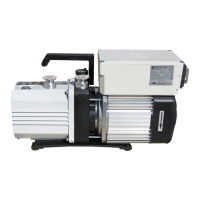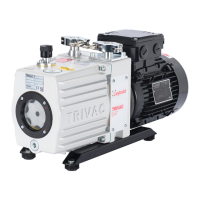WARNING:
ALL TOOLS
MUST
BE DEGREASED BEFORE USE ON PUMPS FILLED WITH PERFLUORO·
POL
YETHER FLUID.
Metric allen wrench set
Medium screwdriver
Phillips
head
screwdriver
Small screwdriver
Small diagonal
cutting
pliers
Snap
ring pliers
Hammer
Drift
pin
or
long
brass
bolt
Metric box
or
ratchet wrench set
Rubber hammer
or
lead
or
brass
faced hammer
Long
nose
pliers
Puller (optional)
Thin wooden
block
to
be
used
as
fulcrum
For D30A,
D60A,
and
D90A
pump models: U.
S.
standard allen and socket wrench
set
For all other pump models: U.
S.
standard box
or
open-end wrench
set
Adjustable spanner;
or
large pair
of
snap
ring pliers
or
two
drill
bits,
drift
pins,
or
other sturdy pins
Cleaning brush
Vernier
calipers
or
micrometers
Paint brush
Shaft
sleeve
or
cellophane tape
Seal
driver (optional)
REMOVING THE
MODULE
FROM
THE
PUMP
WARNING:
IF
THE
PUMP HAS BEEN USED
ON
CORROSIVE
OR
VOLATILE
CHEMICALS, OBSERVE
PROPER
SAFETY
PRECAUTIONS TO PROTECT PERSONNEL BEFORE OPENING
THE
PUMP.
WARNING:
DO
NOT
BEGIN DISASSEMBLING
THE
PUMP
UNTIL
THE
MOTOR SWITCH
IS
TURNED
TO
THE
"OFF"
POSITION
AND
THE
POWER
IS
DISCONNECTED.
NOTE: While
disassembling the pump, note the location
of
the O-rings, gaskets,
and
seals
so
that
the new parts
can
be
placed in the correct locations during reassembly.
Remove the KF clamp ring
from
the intake tube (1)
and
exhaust
port
(6)
to
disconnect the pump from
your
system.
Remove the
dirt
trap
with
O-ring
(2
and 3) from the intake tube (1)
and
the centering ring (7) from the exhaust
port
(6).
Using
an
8-mm allen wrench, remove the
oil-fill
and oil-drain plug
screws
(8) and
flat
gaskets (9) and allow the
lubricating
fluid
to
drain
from
the pump
into
a proper container
(see
Figure 5-1).
Remove the intake tube (1)
from
the oil casing (12)
as
follows:
a.
Unscrew and remove the
screws
and
washers
that
attach the intake tube
to
the oil casing
(see
Figure 5-1).
b.
CAUTION:
WHEN USING A SCREWDRIVER,
USE
CARE TO
AVOID
NICKING
OR
SCRAP-
ING
THE
ALUMINUM
CASING. A
NICK
OR
SCRATCH
MAY
CAUSE AN
EXHAUST
GAS
LEAK
OR
A
LUBRICATING
FLUID
LEAK.
Pull the intake tube (1) up
from
the oil
casing
(12).
If
additional force
is
required, move the
intake tube (1)
from
side-to-side
or
use
a screwdriver
to
pry the tube
from
the casing.
c.
Using care
to
avoid nicking
or
scraping the casing
or
flange, clean the
used
flat
gasket (4) from the
oil casing and/or intake tube
flange.
Repeat Steps
B-4a
through B-4c, except this time remove the
gas
ballast valve assembly (17)
from
the oil
casing (12).
Remove the
oil
filter
(35)
from
the
gas
ballast hole in the oil casing (12)
(see
Figure 5-10B).
NOTE:
For the
D30A,
D60A,
and
D90A
pump models, the oil separator (35) may cling
to
the
gas
ballast
valve
when the valve
is
removed in Step B-5. In this
case,
pull the oil separator
off
of
the
gas
ballast
valve
stem.
WARNING:
PUMP
FLUIDS
ARE
EXCELLENT
LUBRICANTS
AND
AS SUCH ARE
VERY
SLIPPERY.
BE
CAREFUL
WHEN
HANDLING
THE
OIL
CASING SINCE IT CONTAINS
LUBRICATING
FLUID
WHICH
COULD
SPILL
CAUSING A
HAZARD.
nilMl«::
-A·
Manual, Edition L 15
